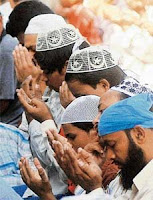Bihu- The Largest Festival Of Assam
>> Saturday, December 26, 2009
Assam, the land of red river and blue hills is an ancient land. Its colorful history traces back to the time of Mahabharata when it was known as Pragjyotishpura. But, during the reign of Ahom rulers, Assam gets its present name.
 This “gateway of north-east India” and political epicenter of the region has its own share of festivals. Most of its festivals are linked with the harvesting of crops as Assam is a agriculturally inclined state. The main festival of Assam is Bihu which is very popular among all the communities residing in this beautiful state.
This “gateway of north-east India” and political epicenter of the region has its own share of festivals. Most of its festivals are linked with the harvesting of crops as Assam is a agriculturally inclined state. The main festival of Assam is Bihu which is very popular among all the communities residing in this beautiful state.
Bihu is a blend of three different secular festivals of the state. Though they owe their origins to the ancient rites and practices, but with the gradual passage of time Bihu became one of the best marketed festival of Assam. Several urban features and Bihu folk songs and dance competitions has added more color to the festival.
Bihu is derived from the term Visuvan, which describes all the Indian festivals that falls in the month of March. Bihu is a combination of three festivals namely Bhogali Bihu (or Magh Bihu), Rongali Bihu (or Bohag Bihu) and last but not the least, Kongali Bihu (or Kati Bihu).
 Rongali Bihu- Among all of them, Rongali Bihu is the most popular one which is celebrated to welcome the Assamese New Year (around 15 April) . It marks the beginning of the Hindu solar calender and observed in the entire state with utmost joy and gaiety. On the very same day, people of other parts of India celebrates festivals like Poila Baishkh(West Bengal), Baisakhi(Punjab), Vishu etc. Rongali Bihu is a festival of merriment and feasting and generally continues for a weak. On the very first day “Goru Bihu” is celebrated which is mainly dedicated to cow worship. It falls on the last day of previous year. On this day cattle are washed, smeared with turmeric powder and other pastes.
Rongali Bihu- Among all of them, Rongali Bihu is the most popular one which is celebrated to welcome the Assamese New Year (around 15 April) . It marks the beginning of the Hindu solar calender and observed in the entire state with utmost joy and gaiety. On the very same day, people of other parts of India celebrates festivals like Poila Baishkh(West Bengal), Baisakhi(Punjab), Vishu etc. Rongali Bihu is a festival of merriment and feasting and generally continues for a weak. On the very first day “Goru Bihu” is celebrated which is mainly dedicated to cow worship. It falls on the last day of previous year. On this day cattle are washed, smeared with turmeric powder and other pastes.
 Second day of Rongali Bihu is known as Manuh Bihu. It is the new year day. On this day, young members of the family shows respect to elders by presenting them gifts like bihuwan (a gamosa), a hachoti (kerchief), a cheleng etc and seek their blessings. Children are given new clothes, and Husori singing begins on this day, and people visit their relatives, friends and savour Assamese dishes like Til pitha, Malpua, Narikolar ladu, Tel Pitha, Aam Pitha, Nimakhiya Pitha etc. Another main attraction of Rongali Bihu is the folk dance and song which are performed by the unmarried Assamese men and women. Attired in golden silk muga, they dance in the open fields on the beats of Flutes, Dhol, Taal, Pepa etc.
Second day of Rongali Bihu is known as Manuh Bihu. It is the new year day. On this day, young members of the family shows respect to elders by presenting them gifts like bihuwan (a gamosa), a hachoti (kerchief), a cheleng etc and seek their blessings. Children are given new clothes, and Husori singing begins on this day, and people visit their relatives, friends and savour Assamese dishes like Til pitha, Malpua, Narikolar ladu, Tel Pitha, Aam Pitha, Nimakhiya Pitha etc. Another main attraction of Rongali Bihu is the folk dance and song which are performed by the unmarried Assamese men and women. Attired in golden silk muga, they dance in the open fields on the beats of Flutes, Dhol, Taal, Pepa etc.
Bhogali Bihu- The word Bhogali comes from the the term bhog which means eating and enjoyment. It is a harvesting festival which marks the end of harvest season. Bhogali Bihu which also known as Maag Bihu, falls in mid-January. It coincides with other Indian festivals like Makar sankranti, Pongal, and Lohri. Uruka, the eve of the main festival falls on the last day of Pausa month. On this day, the younger generation more particularly young men prepares makeshift huts called Bhelaghar with the hay and the Meji. During the night, they prepare food and there is community feasting everywhere. Throughout the night people sing Bihu songs and play various kinds of games. Next morning they take bath and burn the main Meji.
While burning the Meji, people gather around it and throw Pithas (rice cakes) and betel nuts to it. They offer their prayers to the God of Fire and mark the end of the harvesting year. Thereafter they come back home carrying pieces of half burnt firewood for being thrown among fruit trees for favourable results. All the trees in the compound are tied to bamboo strips or paddy stems. Pithas which are made on this occasion are Sunga pitha, Til Pitha, Bhapot Diya Pitha, Narikolar pitha, Bhat Pitha, Tilor Laru etc. Different types of sports like Buffalo-fight, Egg-fight, Cock-fight, Nightingale-fight etc. are held throughout the day.
Kongali Bihu- Kongali Bihu or Kati Bihu is celebrated in mid-October. There is less merriment on this occasion and it is celebrated in solemnity. During this time of the year, the paddy in the fields are in the growing stage and the granaries of the farmers are almost empty. On this day, earthen lamps (saki) are lit at the foot of the household Tulsi plant, the granary, the garden and the paddy fields. To protect the maturing paddy, farmers whirl a piece of bamboo and recite chants of rowa-khowa chants and seek blessing of God, so that they can protect their crop from pests and evil eyes. On this occasion also people exchanges sweets and greetings to their friends and relatives.
By Jolly Mazumdar




